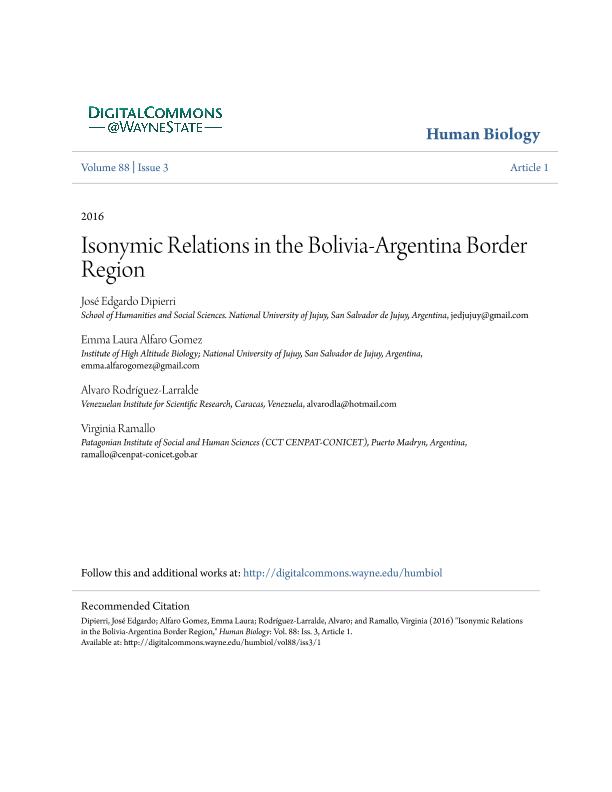Mostrar el registro sencillo del ítem
dc.contributor.author
Dipierri, Jose Edgardo

dc.contributor.author
Alfaro Gómez, Emma Laura

dc.contributor.author
Rodríguez Larralde, Alvaro
dc.contributor.author
Ramallo, Virginia

dc.date.available
2018-03-21T14:53:39Z
dc.date.issued
2016-12
dc.identifier.citation
Dipierri, Jose Edgardo; Alfaro Gómez, Emma Laura; Rodríguez Larralde, Alvaro; Ramallo, Virginia; Isonymic relations in the Bolivia-Argentina border region; Wayne State University Press; Human Biology; 88; 3; 12-2016; 191-200
dc.identifier.issn
0018-7143
dc.identifier.uri
http://hdl.handle.net/11336/39476
dc.description.abstract
When people migrate, they carry their cultural and genetic history, changing both transmitting and recipient populations. This phenomenon changes the structure of the population of a country. The question is how to analyze the impact on the border region. A demographic and geopolitical analysis of borders requires an interdisciplinary approach and isonymic analysis can be a useful tool. Surnames are part of cultural history, socio-cultural features transmitted from ancestors to their descendants through a vertical mechanism similar to that of genetic inheritance. The analysis of surname distribution can substitute quantitative information about the genetic structure. The isonymic relations between border communities in southern Bolivia and northern Argentina were analyzed from electoral registers. This comprised 89 sections included in 4 major administrative divisions, 2 from each country, which includes the international frontier. The Euclidean and geographic distance matrices where estimated for all possible pair wise comparisons between sections. The average isonymic distance was lower in Argentine populations than Bolivian populations. Argentine sections formed three clusters, of which only one cluster included a Bolivian section. The remaining clusters were exclusively formed by sections from Bolivia. The isonymic distance was greater along the border. Regardless of the intense human mobility in the past as in the present, and the presence of three major trans-border conurbations, the Bolivian-Argentine international boundary functions as a geographical and administrative barrier that would differentially affect the distribution and frequency of surnames. The observed pattern could possibly be a continuity of pre-Columbian regional organization.
dc.format
application/pdf
dc.language.iso
eng
dc.publisher
Wayne State University Press

dc.rights
info:eu-repo/semantics/openAccess
dc.rights.uri
https://creativecommons.org/licenses/by-nc-sa/2.5/ar/
dc.subject
Surnames
dc.subject
Isonymic Analysis
dc.subject
Transborder Conurbations
dc.subject.classification
Otras Ciencias Sociales

dc.subject.classification
Otras Ciencias Sociales

dc.subject.classification
CIENCIAS SOCIALES

dc.title
Isonymic relations in the Bolivia-Argentina border region
dc.type
info:eu-repo/semantics/article
dc.type
info:ar-repo/semantics/artículo
dc.type
info:eu-repo/semantics/publishedVersion
dc.date.updated
2018-03-12T17:54:43Z
dc.journal.volume
88
dc.journal.number
3
dc.journal.pagination
191-200
dc.journal.pais
Estados Unidos

dc.description.fil
Fil: Dipierri, Jose Edgardo. Universidad Nacional de Jujuy; Argentina
dc.description.fil
Fil: Alfaro Gómez, Emma Laura. Universidad Nacional de Jujuy. Instituto de Biología de la Altura; Argentina
dc.description.fil
Fil: Rodríguez Larralde, Alvaro. Venezuelan Institute for Scientific Research; Venezuela
dc.description.fil
Fil: Ramallo, Virginia. Consejo Nacional de Investigaciones Científicas y Técnicas. Centro Científico Tecnológico Conicet - Centro Nacional Patagónico. Instituto Patagónico de Ciencias Sociales y Humanas; Argentina
dc.journal.title
Human Biology

dc.relation.alternativeid
info:eu-repo/semantics/altIdentifier/url/http://digitalcommons.wayne.edu/humbiol/vol88/iss3/1
dc.relation.alternativeid
info:eu-repo/semantics/altIdentifier/url/http://digitalcommons.wayne.edu/humbiol_preprints/97/
Archivos asociados
